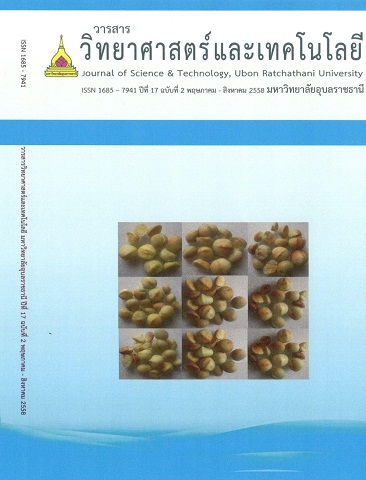Anti-Inflammatory Potential of Ethanolic Bulb Extract of Allium ascalonicum
Main Article Content
บทคัดย่อ
Allium ascalonicum L. is used as a spice and has been used in traditional folk medicines. The anti-inflammatory effect of the ethanolic extract obtained from the bulbs of Allium ascalonicum L. (AAE) was evaluated in vitro. The effect of AAE on RAW264.7 cell viability was measured by the 3-[4,5-dimethylthiazol-2-yl]-2,5-dyphenyl tetra-zolium bromide (MTT) assay. The effect of AAE on the expressions of inflammation associated genes, including inducible nitric oxide synthase (iNOS), cyclooxygenase (COX)-2, COX-1 tumor necrosis factor (TNF)-α, interleukin (IL)-1β and IL-6, in lipopolysaccharide (LPS)-stimulated RAW264.7 cells were determined by using reverse transcription polymerase chain reaction (RT-PCR) technique. Total phenolic content and total flavonoid content analyses were performed by Folin-Ciocalteu reaction and aluminium chloride colorimetric method, respectively. The nontoxic concentrations (62.5, 125, and 250 g/ml) of AAE were used for all experiments. The results indicated that the expressions of iNOS, TNF-α, IL-1β, and IL-6 at the mRNA level were inhibited by AAE in a concentration-dependent manner. AAE did not affect the COX-2 mRNA expression but significantly suppressed the COX-1 mRNA expression. The total phenolic compound of AAE was 15.964 + 0.122 mg gallic acid equivalent. g-1 plant extract. Total flavonoid content of AAE was 11.742 + 0.012 mg quercetin equivalent. g-1 plant extract. The present study revealed that the ethanolic extract of Allium ascalonicum contained constituents such as total phenol and total flavonoid contents and exhibited inhibitory effect against iNOS, and pro-inflammatory cytokines, TNF- α, IL-1β, and IL-6, gene expressions in the LPS-stimulated RAW264.7 cells. Thus, Allium ascalonicum could be further developed to be an alternative anti-inflammatory agent.
หอมแดง (Allium ascalonicum L.) เป็นเครื่องเทศและมีการนำมาใช้ในการแพทย์พื้นบ้าน การศึกษานี้มีวัตถุประสงค์เพื่อทดสอบฤทธิ์ต้านการอักเสบของส่วนสกัดหัวหอมแดงในเอธานอลในหลอดทดลอง ทำการทดสอบความมีชีวิตรอดของเซลล์ด้วยวิธี 3-[4,5-dimethylthiazol-2-yl]-2,5-dyphenyl tetra-zolium bromide (MTT) ศึกษาผลของส่วนสกัดต่อการแสดงออกของยีนที่เป็นสื่อกลางการอักเสบ inducible nitric oxide synthase (iNOS), cyclooxygenase (COX)-2, COX-1, tumor necrosis factor (TNF)-α, interleukin (IL)-1β และ IL-6 ในเซลล์เพาะเลี้ยงมาโครฟาจ (RAW 264.7) ที่ได้รับการกระตุ้นด้วยสาร Lipopolysaccharide (LPS) โดยวัดปริมาณยีนที่แสดงออกด้วยวิธี reverse transcription polymerase chain reaction (RT-PCR) วิเคราะห์หาปริมาณฟีนอลรวมและฟลาโวนอยด์รวมของส่วนสกัดโดยใช้ปฏิกิริยาการเกิดสีกับสาร Folin-Ciocalteu และสารอลูมิเนียมคลอไรด์ ตามลำดับ ผลการศึกษาพบว่าที่ความเข้มข้น 62.5, 125 และ 250 ไมโครกรัม/มิลลิลิตร ส่วนสกัดหอมแดงในเอธานอลไม่มีความเป็นพิษต่อเซลล์และมีฤทธิ์ยับยั้งการแสดงออกของยีน iNOS, TNF-α, IL-1β และ IL-6 เพิ่มขึ้นตามความเข้มข้น ส่วนสกัดหอมแดงไม่มีผลต่อการแสดงออกของยีน COX-2 แต่ยับยั้งการแสดงออกของยีน COX-1 อย่างมีนัยสำคัญ โดยมีปริมาณสารฟีนอลรวมคิดเป็น 15.964 + 0.122 สมมูลกับกรดแกลลิก/กรัม และมีปริมาณสารฟลาโวนอยด์รวม 11.742 + 0.012 มก.สมมูลกับสารเคอร์ซิทิน/กรัม จากผลการศึกษาส่วนสกัดหอมแดงในเอธานอลมีศักยภาพที่จะนำมาพัฒนาเป็นยาต้านการอักเสบในอนาคต
Article Details
บทความที่ได้รับการตีพิมพ์เป็นลิขสิทธิ์ของ วารสารวิทยาศาสตร์และเทคโนโลยี มหาวิทยาลัยอุบลราชธานี
ข้อความที่ปรากฏในบทความแต่ละเรื่องในวารสารวิชาการเล่มนี้เป็นความคิดเห็นส่วนตัวของผู้เขียนแต่ละท่านไม่เกี่ยวข้องกับมหาวิทยาลัยอุบลราชธานี และคณาจารย์ท่านอื่นๆในมหาวิทยาลัยฯ แต่อย่างใด ความรับผิดชอบองค์ประกอบทั้งหมดของบทความแต่ละเรื่องเป็นของผู้เขียนแต่ละท่าน หากมีความผิดพลาดใดๆ ผู้เขียนแต่ละท่านจะรับผิดชอบบทความของตนเองแต่ผู้เดียว


